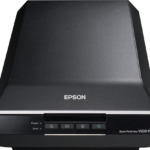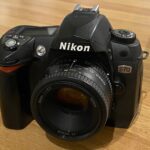In 1989 the autofocus wars were well and truly underway. All major manufacturers had either moved from manual focus entirely, were well on their way to doing so or, like Pentax, reserved manual focus cameras only for their super low price point, entry level cameras to give customers an even more tempting on ramp into the expensive world of SLR photography.
As always with technology, things were moving fast and Canon and Nikon were already well into their second generations of their respective AF systems. Nikon had lined up a very respectable system of cameras and had set about updating the metering and autofocus in each, releasing “S” versions. Later on they’d release “X” versions before giving up entirely on the X01 model naming convention. Canon had arbitrarily started at 600 with their model numbers and had a very serious set of cameras available under their fresh and new EOS 1 flagship.
In late 1989, if you had £400-£500 to spend (approx £1000 – £1300 in 2024 money) and were weighing up whether to join Canon or Nikon, the older EOS 600 and brand new F401S would’ve been firmly in your sights. Given the choice and unlimited 1989 money with which to test drive both cameras, which one would’ve been the better buy?
Let’s find out.
- 2024 Bargains
- Nikon F401S – Overview
- Canon EOS 600 – Overview
- An (almost) side by side test
- And the 1989 best buy is…?
2024 Bargains
Good news. Neither of these cameras have achieved cult or collector status in 2024 and that means one thing – cheap prices and massive bargains. I bought my EOS 600 in as new condition, boxed for just £16 and as if that wasn’t good enough, I bought the F401 in equally good condition for a massive £12.95. That’s at least £2000 worth of 1989 cameras for £28.95. Depreciation is a right sod, isn’t it?


You’ll notice from the images that I now have a nice collection of after market manuals/books for these cameras. Reading the manual was a really big thing back then – not only did manufacturers urge you to read the manual cover to cover, but magazines too would extol the virtues of never forgetting to read the manual thoroughly before even daring to take your new light box out for a drive. These after market manuals were massive sellers and did indeed contain piles of information and shooting tips for your new investment.
Both cameras came in incredible condition. The EOS 600 looked like it had been out of the box once and then very carefully packed back up again and left to have a nice rest for 30 years. It came with a lithium battery with an expiry date of 2010, which means it was probably purchased some time around 2008. I was about to recycle it when I thought I’d pop it in the camera to see what happened.

Full? How can it be fully charged after so many years? Not believing the battery meter on the camera one bit, I whipped out the multimeter. I can confirm that this battery, which is at least 16 years old, was still pumping out well over the 6v it was supposed to supply. That’s mad. Lithium battery technology really is very impressive.
What about the F401S? That too had been very well cared for in its life. The battery compartment was clean with no signs of leakages and the protective film was still present on the plastic cover which goes over the mode dials on top of the body. All in all, I’d say these are some of the most pristine cameras I’ve ever picked up regardless of price. The price I paid just makes the whole deal something of a total bargain.
Nikon F401S – Overview

When reading up on the Nikon F401S, one thing kept coming up time and again – metering. Metering, metering, metering. Previews, reviews and indeed any other mention of the camera nearly always referred to its incredible metering system that used a sophisticated multi-segment arrangement to give you uncannily accurate results. The second generation AF on the F401S was something of an afterthought.
The design of the F401S is undoubtedly unique and causes something of a marmite reaction amongst owners and users. The top of the body houses the brilliantly named “Master Image Control” which is the most “1980’s looking to the technologically advanced future” thing I’ve ever seen.

What is “Image Master Control?” Well… it’s… er… Shutter speed and aperture dials. These are not just any shutter speed and aperture dials, these are dials with a universal lock button and a nice plastic cover. Premium dials indeed. I do shamelessly love it, though. The shutter speed dial is used to turn the camera on and off from the red “L” position and when both dials are set to S and A respectively, the camera is in full program mode. That’s program mode with no shift, though, we’re talking full auto point and shoot mode. One final word on that plastic cover – if you don’t know this camera you could very easily assume that this is nothing more than a dust cover and be tempted to try and remove it. My body, and I’m sure others too, do show signs of where people have tried to lift it off before encountering resistance that makes you think twice.
The body itself is gloriously chunky. I am an advocate for sensibly sized bodies with decent ergonomic grips and the F401S fits the bill nicely. It isn’t overly heavy, and it feels very sturdy and secure in the hand thanks to a plentiful and well designed hand grip. The overkill large Nikon embossed logo on the grip is a great statement piece, I wish they’d kept this in future models.

Film advance and rewind are both automatic and you can rewind a film mid-roll without issue. There is a very odd and rather pointless film advance indicator on the back which shows if the film is actually moving or not. Short of a cursory check when first loading the film, I’m not sure anyone ever looked at this as it’d involve moving your face away from the back of the camera as the shutter is fired to see its little animation.
As usual, AF is provided by, umm… well, I don’t know, some kind of Nikon lens. This is the worst thing about Nikons, I cannot stand their lens nomenclature and the absurd difficulty that newcomers face when trying to understand if a certain lens will work with a certain body. The 50mm I have will work perfectly with a range of Nikons, the F401S and a much later F65 for example, but put it on an F801 body and it works in every mode except aperture priority. Here’s the truly absurd bit, if you put it in program mode it’ll happily control the aperture for you?! What on earth is that all about? Canon win hands down here – FD = manual, EF = autofocus. That’s it. No messing about. Why, Nikon, why?!
Other than that, Nikon pulled a blinder by choosing AA batteries as the power source. I love cameras that take widely available, cheap and, more importantly, rechargeable power sources. The 2CR5 batteries that were common in cameras of this era are fine, they last an eternity but they’re not rechargeable and are very expensive to replace. AA batteries fit nicely and are super convenient if you run out – just pop into pretty much any shop and you’re back in business.
Finally, the viewfinder leaves a lot to be desired. There are a couple of LED’s that will flash red, green or in a circle depending on whether AF has been achieved and the exposure settings are within tolerance. Past this, you get nothing. You shall not know the settings that the camera has chosen if you use it in program mode. Should you want to know exactly what the shutter and aperture settings are, you’re going to need to set both manually on the “Image Master Control.”
Canon EOS 600 – Overview

There’s no argument, the EOS 600 is the more advanced and feature filled camera. This unassuming, gunmetal grey body is capable of rattling off no fewer than five frames per second. In film land, in 1990, that was seriously impressive. You’d have needed an EOS 1n with battery grip to go faster than that and you’d have paid almost £1000 more for 1fps better performance.
Looking past the speed, the EOS 600 offers all the shooting modes you’d expect including a program mode with shift function. The LCD display on the top panel gives clear information about shooting settings and the current status of the camera in terms of AF mode, drive, frames used and so forth. This is a design which remained largely unchanged right into the digital SLR era and “just makes sense.” Indeed, a lot of the EOS 600 design is borrowed from the excellent T90 which had paved the way in terms of design language and ergonomics for all future Canon cameras.
The quick control wheel makes light work of changing settings without moving the camera from your eye and, whilst on the subject of your eyes, the viewfinder contains the usual range of information you’d expect from a Canon SLR – shutter speed, aperture and exposure compensation.
The only omission from this camera that annoyed me was a lack of selectable metering modes. You can, with some button holding finger gymnastics, force it into spot metering mode but this is nowhere near as easy as just… selecting a metering mode. This was available on the EOS 1 at the time, perhaps Canon didn’t want to trickle that particular function down just yet, but it’s a noticeable omission that, for such a capable camera, really doesn’t make sense.

Although the EOS 600 looks subtly different to later EOS models, it’s mostly coming from the modelling of the grip. It has the interesting but functionally questionable sloping cut away of the T90 on the base and what appears to be a grip that’s too thin. There’s nothing wrong with the grip in use, it fits the hand quite nicely, but as a matter of personal preference, it doesn’t feel as good nor secure as the Nikon F401S. Whilst we’re on the subject of design cues, the EOS 600 sports a power button dial on the back which was quickly dropped by Canon for later EOS models, only to make a surprise resurrection on the digital EOS D30 and D60 models. A curious come back!
An (almost) side by side test
If you’ve got this far you’d be forgiven for thinking this is a foregone conclusion and that these cameras are not really comparable. But they really are, and the results were quite surprising. On paper the EOS 600 beats the Nikon hands down – it is packed with features, usability tweaks and custom functions. The F401S offers you AF, great metering and thats about it. How can there be any competition?

These two cameras were absolutely in direct competition in terms of price. Nikon had a habit of selling their cameras for higher prices than other brands and consequently the ranges didn’t stand up to side by side price comparison. If you wanted feature compatible models, you’d have needed to buy a Nikon F801S and that would’ve set you back a fair chunk more than an EOS 600. On a pure price comparison level, these would’ve been two cameras to consider with your roughly £500 budget back in 1990 and it would’ve then come down to your requirements, features you wanted and whether you’d already bought into a lens system or not.
I strapped a 50mm lens to both cameras, loaded each with a new roll of Kodak Tri-X 400 and headed off to Birmingham for a day on the streets. You can’t do an exact side by side comparison when you’re one person and you’re shooting street – it’s not like you can go back and ask people to repeat what they did 15 seconds ago. However, you get a great sense of how the cameras behave in different circumstances, how well the AF reacts to quick fire situations and what the metering thinks of similar scenes. Both cameras were used in their respective program modes.
I began by using the EOS 600 and immediately came upon a scene where I’d be able to rattle off a few shots on both cameras.
 |  |
| Canon EOS 600 | Nikon F401S |
Straight away I noticed that the Canon behaves in what I can only describe as a more deliberate manner. It settled on a shallower depth of field, which I like, but only when focus is accurate and quick enough to make use of it. The focus on the EOS 600 is very reminiscent of the Canon EOS 5 I reviewed not so long ago. If the 600 doesn’t immediately grab focus then it won’t shoot full stop and there are plenty of occasions where it would hunt at the least appropriate moment. Expecting exactly the same from the Nikon, I was immediately proven wrong.
The F401S failed me once and once only in an entire roll of film. Time and time again it would at least grab on something and fire off the frame rather than having that heart breaking press of the shutter with zero response. Honestly, I’d rather chance at the focus being good enough at the point of pressing the shutter and risk an out of focus shot than having none at all. Later Canon cameras do have this option as a custom function, but the EOS 600 does not. 1-0 to the F401S, then.

I bumped in to a couple of street photographers whilst holding the Nikon in my hands. One of them suddenly asked “Why are you shooting everything at F22?!” Well, I wasn’t… A quirk of the Nikon D AF lenses is that they need to be in F22 to be in auto aperture mode. The controls of the F401S are certainly eccentric at times and Nikon definitely designed this to be a “set and forget” camera. The good old Image Master Controls are not in any way easily accessible when you have the camera to your eye so you can forget simply scrolling through the shutter speeds, for example, whilst composing a shot.
The viewfinder of the F401S confirms this, you can change the settings if you like but they won’t show up in the viewfinder. This is odd – it’s not like the technology didn’t exist, cameras from the 1970’s could display the aperture and shutter speed to you in the viewfinder. No, instead this was a conscious design decision by Nikon to simplify the user experience and I think that comes down to the metering system. Nikon were so confident that the metering system was spot on that you wouldn’t need to see any extra information other than a dot confirming everything is good to go.
This is a contradiction that some couldn’t get their heads around in the early 1990’s, the idea that someone would buy an SLR with all it’s manual control for “real photographers” and then whack it in the green program mode and start shooting sent some people round the bend. The sheer rage in the letters pages of Amateur Photographer at the time are testament to this and also deeply hilarious, as if somehow technology was somehow removing the very soul of photography.
It is an interesting debate, though. I personally don’t enjoy point and shoot photography at all, but then I don’t mind sticking an SLR into program mode half of the time. I enjoy film far more than digital, but there are plenty of occasions where I appreciate the sheer convenience of pure digital imaging and I really have never got on board with mirrorless cameras. This is a case of the same problem, different era and must be true of all passions. You only need to look at motorsports to see how upset electric cars make some people.

Undoubtedly, the Canon EOS 600 has the better controls. Ergonomically it is better designed and extremely well thought out – there’s no denying the quick control dial is the most simple, convenient and effective way of using a camera without taking your eye away from it. However, I don’t think it’s a straight comparison because as just discussed the F401S wasn’t designed to be this kind of camera, the customer for this camera was highly likely to be a 90% program mode user.
One control I would like to have seen on the F401S is quick exposure compensation but that again is missing probably due to the lack of viewfinder info making it a pointless or even unusable feature anyway.
And the 1989 best buy is…?

In 1989, if you had £500 to spend on a camera outfit I think you’d have been mad to not buy the Canon. It is a monumental piece of engineering with some superb specifications, useful custom functions and that super fast motor drive for burning up cheap film. Couple that with the easy to understand AF lens system and a superb array of available glass and you’ve got an almost unbeatable combination.
Hands down winner, then. Right?
Well. No.
Whilst the EOS 600 is definitely better on paper, I simply didn’t enjoy it as much for one reason. You’ve probably guessed why already – AF performance.
The whole point in an AF camera is that you use and rely on the AF system for your images. There’s nothing wrong with the EOS 600 AF in most situations, but it just has that nasty habit of letting you down when you need it the most. In my opinion, the AF in the F401S is better. It seemed equally, if not slightly more snappy than the EOS 600 and it was always ready to fire a shot off when I needed it to. That, to me, is a deal maker. You can give me all the options, controls and configuration in the world, but if a camera doesn’t have decent AF performance then I’d rather not bother.
 |  |
| Canon EOS 600 | Nikon F401S |
Then there’s the metering. Did both cameras live up to their respective hype? The answer is a definite yes. The EOS 600 produced well balanced pictures and seemed to make very sensible decisions even in backlit situations. However, the F401S seemed to meter in a way which I preferred. I didn’t have to do a great deal of work to any of the pictures taken with either camera, but I definitely did less after scanning the F401S images than I did with the EOS 600. the F401S shots required slightly less controlling of the highlights and it had an uncanny knack of metering perfectly for faces.
Finally, and purely a personal preference thing, I think the Nikon F401S looks fantastic. I know looks don’t mean a thing, especially in terms of function, but I do like it when designers do something a little different to make a product stand out. Plus the grip on the F401S bucked the trend at the time for smaller, lighter cameras and I thank Nikon for that, it’s a much better experience when you’ve got a nice chunky, confidence inspiring grip to hang on to – especially as I don’t like camera straps.

So it’s a win for the F401S then?
Er…
No. Actually, I think it’s a score draw.
Both cameras need to be used for the use cases they were designed for. In those circumstances they excel. If I were to pick one for the streets, it would be the F401S hands down as the AF is more reliable, the body nicer to hold and you only need the very, very reliable program mode and automatic metering. For almost every other kind of photography, however, I’d pick the EOS 600 every time. For times when you need information, creative control, feedback from the camera, exposure compensation, multiple exposures and so forth, then you need the EOS 600.
The Canon certainly justified it’s £50 ish price premium at launch and these two cameras just go to show that purchasing decisions should never be based solely on price. If customers had done so back in 1990 then there would’ve been some very happy people and some very disappointed that they made the wrong choice. Nikon saw themselves as the Apple of the day and commanded a price premium for their products – a premium that was confusing for newcomers to the market and getting harder and harder to justify as Canon came in with their EOS steamroller and started to prise the professional market away from the absolute Nikon dominance they had enjoyed with their F4 and F5 bodies.
And what about value in todays market? That leads us to another fairly predictable conclusion. Both cameras are stupidly cheap to buy today, both will get you entry into the respective lens systems that each offers, both will be reliable cameras that produce pleasing pictures when developed. As a first film SLR, the Nikon is hard to recommend as it doesn’t really give you much more than a point and shoot experience with the obvious benefits of SLR lens quality and the option for manual should you want it.

The EOS 600, however, gives you almost everything you could possibly want from an SLR for a really knock down price. I don’t think many people realise just how seriously capable this camera is, perhaps because it’s a first generation product and doesn’t get much exposure when compared to some of the more “exciting” cameras like the EOS 1 or 3. Matt Richardson of “clickbait” and “furious driving” YouTube fame recently mentioned his 600 in a video and he loves it – it’s the only Canon he needs.
These days, motor drive speeds just don’t matter as almost no one can afford to smash out 5 or 6 fps bursts with merry abandon so the rapid fire ability of this camera becomes something of a moot point. With that in mind and the fact that the AF is good but not good enough then it becomes a slightly harder sell at this point.
That’s because, as I’ve said before, later Canon bodies offer all the features of the EOS 600, minus the 5fps burst, but with the added bonus of much, much, much better AF performance. If you don’t mind a compact body size then the 300X is by a country mile the best value Canon AF film body out there. It’s an absolute machine due to the fact it was the last ever EOS body made and packed with similar technology in terms of AF to the 350D. There are, of course, plenty of other options if you want something more traditional – the ever superb 500n for example would do most people down to the ground. All of these options are available for the same price as an EOS 600 or Nikon F401S.
These, then, are two great cameras that are “of their time” and there’s nothing wrong with that. If you find one for cheap, as I did, then pick them up and have a go by all means, just perhaps don’t pursue one as your dream film SLR. Apart from the EOS 600 if you fancy seeing what a film motor drive can really do for £10…










